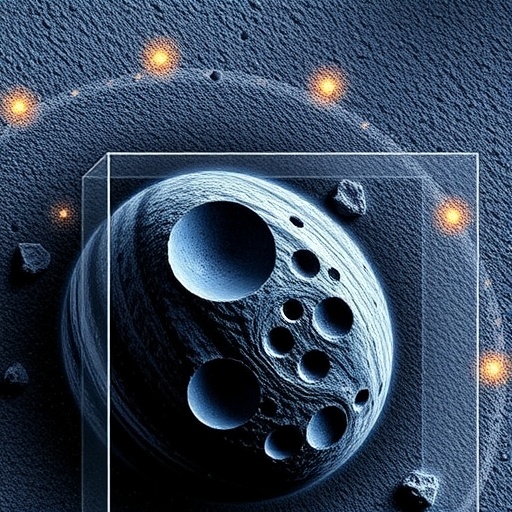New findings from NASA’s groundbreaking OSIRIS-REx mission, the first mission dedicated to the return of samples from an asteroid, are transforming our understanding of the composition and behavior of gray asteroids. This research sheds light on why certain gray asteroids exhibit differential reflectance of light at varying wavelengths, such as red or blue. By analyzing how these celestial bodies reflect light across different spectrum ranges, scientists are uncovering profound insights into the evolutionary history of rocky formations throughout the solar system.
The mission, an ambitious venture aimed at collecting and returning samples from the asteroid Bennu, has significant implications for future exploration. With enhanced comprehension of how telemetry and telescope data correlate with actual surface particles, researchers will be better equipped to guide astronauts and scientists in selecting asteroids for research and potential resource extraction. This leap in knowledge will pave the way for targeted investigations that could yield valuable insights and materials from these ancient cosmic remnants.
Among the distinguished scientists involved in this groundbreaking work is Michelle Thompson, an associate professor specializing in Earth, atmospheric, and planetary sciences at Purdue University. Her expertise in space weathering—the phenomenon where rocky bodies interact with their space environments—has led her to seek answers about various celestial bodies, including Bennu. Thompson, part of an international team studying the recently returned samples from Bennu, emphasizes that the OSIRIS-REx mission stands as a hallmark of planetary science, bridging over a decade of collaborative efforts among hundreds of researchers.
Fascinatingly, Thompson notes a disparity between how asteroids reflect light, even when they share similar mineral compositions. Despite both Ryugu and Bennu being carbonaceous and characterized as rubble-pile asteroids that originated from the early solar system, their light reflection properties differ significantly. When observed through telescopic instruments, Ryugu appears faintly red, indicating an upward slope in its spectral characteristics, while Bennu displays a blue hue with a downward slope.
The pivotal question arising from these observations is why such differences exist between the two bodies. Initially, researchers hypothesized that varied space weathering processes could account for this disparity. However, Thompson and her colleagues discovered that both asteroids undergo remarkably similar space weathering effects. Instead of representing divergent evolutionary trajectories, the observed spectral differences are indicative of varying ages of exposure on their surfaces.
Throughout time, rubble-pile asteroids like Bennu and Ryugu experience cycles where their surfaces are periodically rejuvenated, altering their visual characteristics. Scientists found that while the surface grains collected from Ryugu have been exposed to the harsh conditions of space for thousands of years, those from Bennu have endured exposure for tens of thousands of years, thus contributing to their nuanced spectral differences.
The ability to correlate visual and telescopic data with sample analysis provides researchers with a unique opportunity to validate their findings against real materials collected from space. This comparison—often referred to as ground-truthing—allows scientists to apply their insights across a broader spectrum of celestial bodies, potentially extending this method of analysis to other airless bodies including moons and dwarf planets.
In an exciting revelation earlier this year, a collaborative team of scientists announced the presence of salts within the Bennu samples, specifically phosphates—a crucial component for life on Earth. Their findings suggest the existence of ancient brine, a potentially life-sustaining environment that could have facilitated the formation of essential compounds for life’s chemistry.
Understanding these minerals alongside the organic molecules present in Bennu’s samples is critical to unraveling the complex interactions that shaped our solar system’s early history. By studying the organic materials retrieved from Bennu, researchers can glean insights into the compounds that may have seeded life on Earth, examining existing elements and their proportions. While researchers are not looking for direct evidence of life, they are hunting for the primal building blocks that could have laid the groundwork for biological evolution.
The pristine condition of Bennu’s materials, preserved in their untouched state, offers scientists a rare glimpse into the solar system as it existed before planets formed in their current configurations. These ancient asteroids serve as fossil records of the nascent solar system, functioning as time capsules that can illuminate our understanding of the solar system’s origins and the potential pathways toward the emergence of life on Earth.
As the OSIRIS-REx mission continues to yield data, it marks a significant milestone in planetary research. This marks humanity’s third foray into asteroid sample return missions after Japan’s Hayabusa and Hayabusa2 missions to asteroids Itokawa and Ryugu. Moreover, it showcases the importance of interdisciplinary collaboration and the challenge of exploring the vastness of space while broadening our understanding of the cosmos.
In conclusion, the OSIRIS-REx mission proves to be an invaluable asset in our quest to comprehend the universe’s complexities. As researchers analyze Bennu’s samples, they are taking critical steps toward expanding our knowledge of planetary formation, evolution, and the potential for life beyond Earth. The unique findings not only deepen our understanding of asteroids, but also deliver lessons about our own planet’s history and the conditions that may have fostered life’s emergence here.
Subject of Research: The surface composition and light reflectance of asteroids, specifically Bennu, in relation to their evolutionary processes.
Article Title: Sulfide Minerals Bear Witness to Impacts Across the Solar System.
News Publication Date: 1-Jul-2025
Web References: NASA’s OSIRIS-REx Mission
References: Nature Communications – Sulfide Minerals
Image Credits: Credit: Purdue University/Kelsey Lefever
Keywords
OSIRIS-REx, asteroid Bennu, light reflectance, space weathering, organic molecules, planetary science, sample return mission, early solar system, extraterrestrial life.




